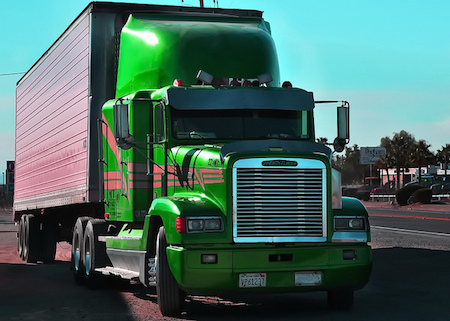Any wheeled vehicle that is coasting will slow down gradually due to rolling resistance. A steel-wheeled vehicle such as a locomotive will roll further than a rubber-tired vehicle of the same mass on pavement.
A tire’s rolling resistance rating is relative to the amount of energy lost when the tire flexes (squishes) when it meets the road surface. This energy loss process is known as hysteresis.
Hysteresis is a characteristic of a deformable material such that the energy of deformation is greater than the energy of recovery. This energy loss is dissipated as heat.
As a truck tire rotates, the weight of the truck causes a deformation and recovery of the tire. This cycle is repeated over and over.

The engine of the truck burns fuel to produce the power (energy) to turn the tires, so this hysteresis energy loss directly affects the amount of fuel needed to move the truck a given distance. Multiply this energy loss by 18 wheel positions and you can see how it can have a significant impact on fuel mileage. As much as 30% of the energy that ends up making it to the tire is given up by friction or hysteresis
Remember, tires have the biggest impact on mpg below 50 mph.
So if we want to get maximum fuel mileage it sounds like solid steel wheels would give us the lowest rolling resistance. Not a very appealing option for a driver’s back, not to mention hammering the truck to pieces. In years past we had to find a compromise between a comfortable ride and good fuel mileage when it came to buying tires. A tire with a harder rubber compound would have less deflection meaning lower rolling resistance (better mpg) but would have a stiffer ride. A tire that provided a softer ride deflected more, increasing the rolling resistance (worse mpg).
Today’s tire manufacturers have developed new rubber compounds that allow for a comfortable ride while providing low rolling resistance.
Since fuel cost is an owner/operator’s biggest variable expense it only makes sense to heavily weigh a tire’s rolling resistance rating when choosing which new tires you are going to purchase. Choosing those “blue light specials” over a good low rolling resistance tire might be appealing due to the lower initial cost but the additional fuel expense over time will likely far exceed your initial savings.
Today there are many more options for tires that provide a comfortable ride, good fuel economy, and long life. It will definitely be worthwhile to take the time to research which tires will meet your traction requirements, provide good fuel mileage, a comfortable ride, and long life.